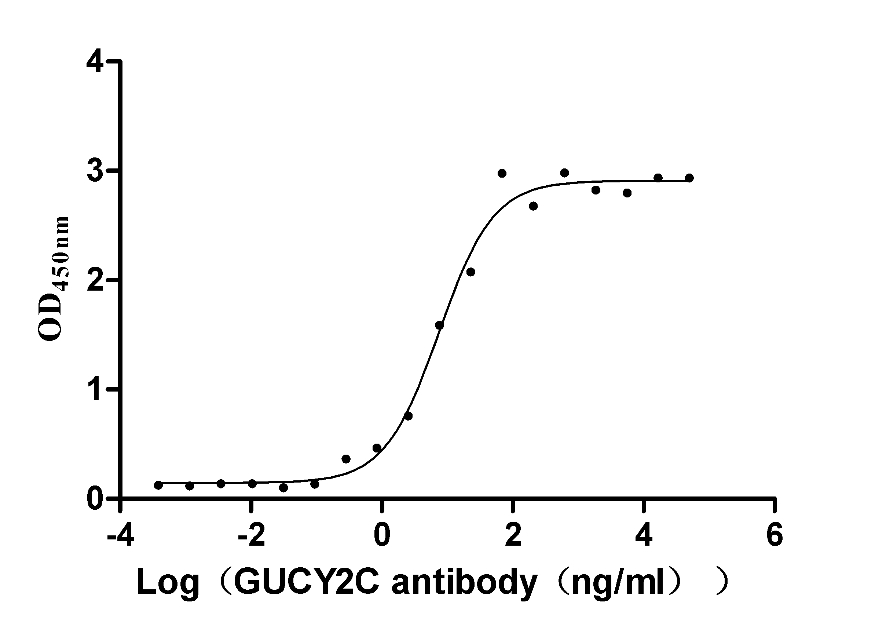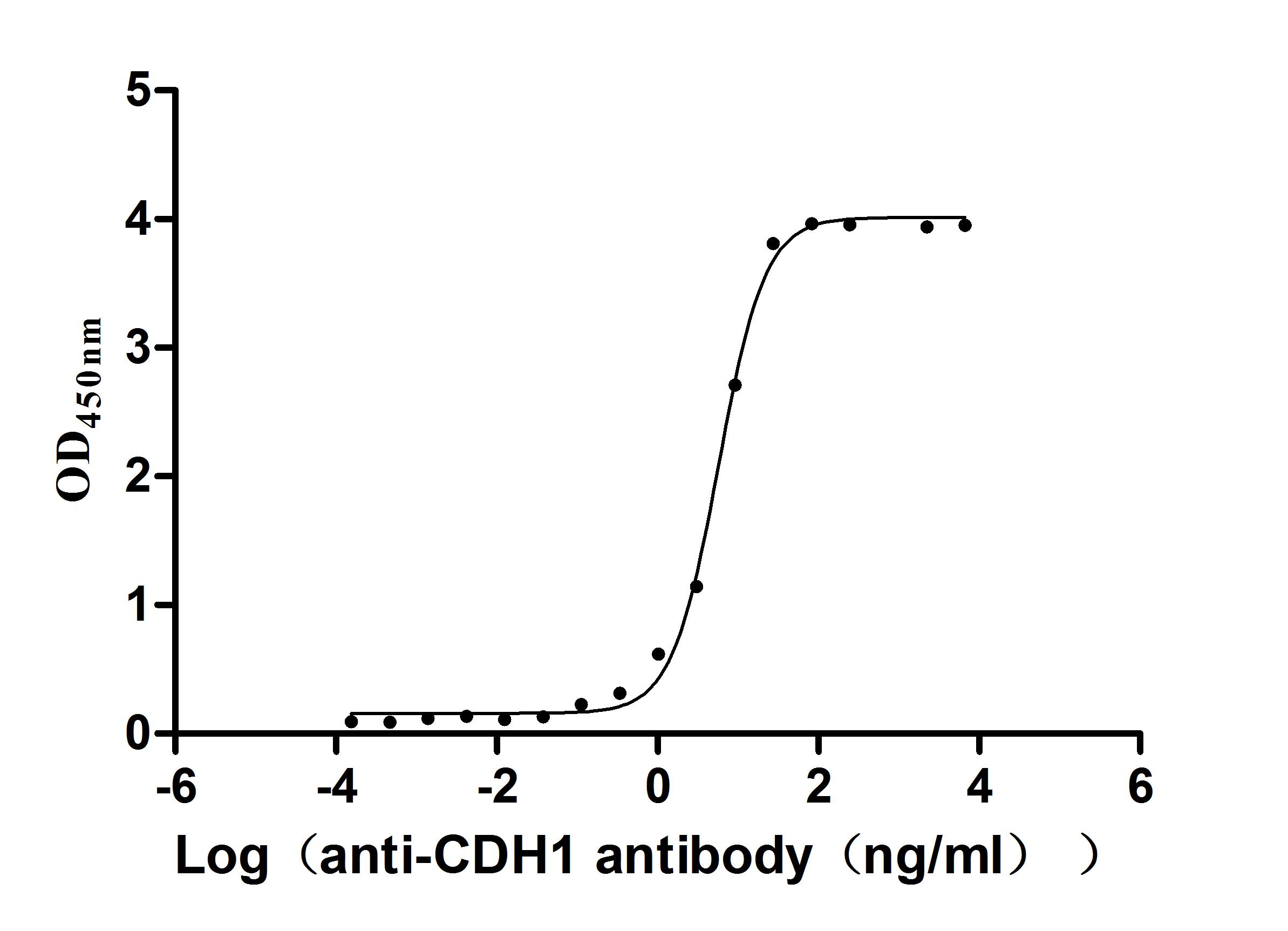Recombinant Mouse Glypican-1 (Gpc1)
-
货号:CSB-YP879473MO
-
规格:
-
来源:Yeast
-
其他:
-
货号:CSB-EP879473MO
-
规格:
-
来源:E.coli
-
其他:
-
货号:CSB-EP879473MO-B
-
规格:
-
来源:E.coli
-
共轭:Avi-tag Biotinylated
E. coli biotin ligase (BirA) is highly specific in covalently attaching biotin to the 15 amino acid AviTag peptide. This recombinant protein was biotinylated in vivo by AviTag-BirA technology, which method is BriA catalyzes amide linkage between the biotin and the specific lysine of the AviTag.
-
其他:
-
货号:CSB-BP879473MO
-
规格:
-
来源:Baculovirus
-
其他:
-
货号:CSB-MP879473MO
-
规格:
-
来源:Mammalian cell
-
其他:
产品详情
-
纯度:>85% (SDS-PAGE)
-
基因名:Gpc1
-
Uniprot No.:
-
别名:Gpc1; Glypican-1 [Cleaved into: Secreted glypican-1]
-
种属:Mus musculus (Mouse)
-
蛋白长度:Full Length of Mature Protein
-
表达区域:24-529
-
氨基酸序列DPASKSR SCSEVRQIYG AKGFSLSDVP QAEISGEHLR ICPQGYTCCT SEMEENLANH SRMELESALH DSSRALQATL ATQLHGIDDH FQRLLNDSER TLQEAFPGAF GDLYTQNTRA FRDLYAELRL YYRGANLHLE ETLAEFWARL LERLFKQLHP QLLPDDYLDC LGKQAEALRP FGDAPRELRL RATRAFVAAR SFVQGLGVAS DVVRKVAQVP LAPECSRAIM KLVYCAHCRG VPGARPCPDY CRNVLKGCLA NQADLDAEWR NLLDSMVLIT DKFWGPSGAE SVIGGVHVWL AEAINALQDN KDTLTAKVIQ ACGNPKVNPH GSGPEEKRRR GKLALQEKPS TGTLEKLVSE AKAQLRDIQD FWISLPGTLC SEKMAMSPAS DDRCWNGISK GRYLPEVMGD GLANQINNPE VEVDITKPDM TIRQQIMQLK IMTNRLRGAY GGNDVDFQDA SDDGSGSGSG GGCPDDTCGR RVSKKSSSSR TPLTHALPGL SEQEGQKTS
-
蛋白标签:Tag type will be determined during the manufacturing process.
The tag type will be determined during production process. If you have specified tag type, please tell us and we will develop the specified tag preferentially. -
产品提供形式:Lyophilized powder
Note: We will preferentially ship the format that we have in stock, however, if you have any special requirement for the format, please remark your requirement when placing the order, we will prepare according to your demand. -
复溶:We recommend that this vial be briefly centrifuged prior to opening to bring the contents to the bottom. Please reconstitute protein in deionized sterile water to a concentration of 0.1-1.0 mg/mL.We recommend to add 5-50% of glycerol (final concentration) and aliquot for long-term storage at -20℃/-80℃. Our default final concentration of glycerol is 50%. Customers could use it as reference.
-
储存条件:Store at -20°C/-80°C upon receipt, aliquoting is necessary for mutiple use. Avoid repeated freeze-thaw cycles.
-
保质期:The shelf life is related to many factors, storage state, buffer ingredients, storage temperature and the stability of the protein itself.
Generally, the shelf life of liquid form is 6 months at -20°C/-80°C. The shelf life of lyophilized form is 12 months at -20°C/-80°C. -
货期:Delivery time may differ from different purchasing way or location, please kindly consult your local distributors for specific delivery time.Note: All of our proteins are default shipped with normal blue ice packs, if you request to ship with dry ice, please communicate with us in advance and extra fees will be charged.
-
注意事项:Repeated freezing and thawing is not recommended. Store working aliquots at 4°C for up to one week.
-
Datasheet :Please contact us to get it.
相关产品
靶点详情
-
功能:Cell surface proteoglycan that bears heparan sulfate. Binds, via the heparan sulfate side chains, alpha-4 (V) collagen and participates in Schwann cell myelination. May act as a catalyst in increasing the rate of conversion of prion protein PRPN(C) to PRNP(Sc) via associating (via the heparan sulfate side chains) with both forms of PRPN, targeting them to lipid rafts and facilitating their interaction. Required for proper skeletal muscle differentiation by sequestering FGF2 in lipid rafts preventing its binding to receptors (FGFRs) and inhibiting the FGF-mediated signaling. Binds Cu(2+) or Zn(2+) ions.
-
基因功能参考文献:
- This study provides new insights into the roles of GPC1 and GPC3 in mandibular morphogenesis. GPC3-knockout reduces mandibular growth, but GPC1 does not. These findings along with previous studies indicate that glypicans could be potential therapeutic agents to manage craniosynostosis and associated bony dysmorphology. PMID: 28426184
- Data show that notum and glypican-1 and glypican-3 gene expression during colorectal cancer (CRC) development and present evidence to suggest them as potential new biomarkers of CRC pathogenesis. PMID: 26517809
- Amyloid precursor protein (APP)/APP-like protein 2 (APLP2) expression is required to initiate endosome-nucleus-autophagosome PMID: 24898256
- The N-terminal growth-factor-like domain of amyloid-beta precursor protein is necessary for protein-receptor binding, whereas the E2-domain mediates interaction with membrane-anchored syndecan 2 and glypican 1. PMID: 23986479
- Glypican-1 is expressed by neural stem cells and neurons derived from embryonic stem cells, which are then surrounded with cell bodies and processes, which in certain cases show distinctive expression patterns. PMID: 20689858
- Glypican-1 is a novel cellular cofactor for prion conversion. It acts as a scaffold facilitating the interaction of PrP(C) and PrP(Sc) in lipid rafts. PMID: 19936054
- data imply that endogenous Gpc1 is involved in control of growth factor signaling, a finding that is both novel and relevant to the general question of how the activities of co-receptors are exploited during development PMID: 19732411
- Data describe a relationship between heparan sulfate and copper binding of amyloid precursor protein (APP) and amyloid precursor-like protein 2 (APLP2) in the modulation of nitroxyl anion-catalyzed heparan sulfate degradation in glypican-1. PMID: 15677459
- cancer cell- and host-derived GPC1 are crucial for full mitogenic, angiogenic, and metastatic potential of cancer cells PMID: 18064304
- GPC1 regulates EC cell cycle progression at least partially by modulating APC/C-mediated degradation of mitotic cyclins and securin PMID: 18417614
- These results suggest a role for Gpc-1 autoprocessing in the clearance of PrP(Sc) from infected cells. PMID: 18717736
- GPC1 may have an important role in the establishment of a microenvironment that supports early events in hematopoiesis. PMID: 18840400
显示更多
收起更多
-
亚细胞定位:Cell membrane; Lipid-anchor, GPI-anchor; Extracellular side. Endosome. Note=S-nitrosylated form recycled in endosomes. Localizes to CAV1-containing vesicles close to the cell surface. Cleavage of heparan sulfate side chains takes place mainly in late endosomes. Associates with both forms of PRNP in lipid rafts. Colocalizes with APP in perinuclear compartments and with CP in intracellular compartments. Associates with fibrillar APP amyloid-beta peptides in lipid rafts in Alzheimer disease brains.; [Secreted glypican-1]: Secreted, extracellular space.
-
蛋白家族:Glypican family
-
数据库链接:
KEGG: mmu:14733
STRING: 10090.ENSMUSP00000047199
UniGene: Mm.297976
Most popular with customers
-
Recombinant Human Heat-stable enterotoxin receptor (GUCY2C), partial (Active)
Express system: Mammalian cell
Species: Homo sapiens (Human)
-
Recombinant Human Insulin growth factor-like family member 1 (IGFL1) (Active)
Express system: Mammalian cell
Species: Homo sapiens (Human)
-
Recombinant Human Mucin-17 (MUC17), partial (Active)
Express system: Mammalian cell
Species: Homo sapiens (Human)
-
Recombinant Human C-C chemokine receptor type 8 (CCR8)-VLPs (Active)
Express system: Mammalian cell
Species: Homo sapiens (Human)
-
Recombinant Human Carcinoembryonic antigen-related cell adhesion molecule 8(CEACAM8) (Active)
Express system: Mammalian cell
Species: Homo sapiens (Human)
-
Recombinant Macaca fascicularis C-type lectin domain family 4 member C(CLEC4C), partial (Active)
Express system: Mammalian cell
Species: Macaca fascicularis (Crab-eating macaque) (Cynomolgus monkey)
-
Recombinant Human Cadherin-1(CDH1),partial (Active)
Express system: Mammalian cell
Species: Homo sapiens (Human)
-
Recombinant Human C-C chemokine receptor type 9 (CCR9)-VLPs (Active)
Express system: Mammalian cell
Species: Homo sapiens (Human)




















